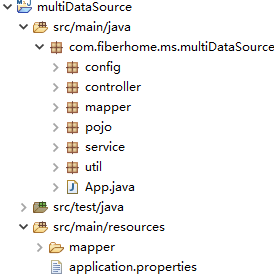springboot整合mybatis的多数据源解决办法
最近项目有一个非解决不可的问题,我们的项目中的用户表是用的自己库的数据,但是这些数据都是从一个已有库中迁过来的,所以用户信息都是在那个项目里面维护,自然而然我们项目不提供用户注册功能,这就有个问题,如何解决数据迁移的问题,总不能我每次都手动导数据吧,所以我决心写一个接口把那个库中的用户信息同步我们的库中去。
这又涉及到一个问题,如何在一个服务中连接两个库,在网上搜索了一番,算是把问题解决了,现将多数据源demo代码贴出来,先看一下我的目录结构

controller、mapper、pojo、service这几个常见的业务逻辑包我们放到最后看,先看一下util包里面的类
DatabaseType
/** * 采用枚举的方法列出所有的数据源key(常用数据库名称来命名) * 数据源个数和数据库个数保持一致 */ public enum DatabaseType { mytestdb,mytestdb2 }
这里就是列出所有的数据源,相当于定义了两个常量,便于统一维护
DynamicDataSource
import org.springframework.jdbc.datasource.lookup.AbstractRoutingDataSource; /** * 动态数据源(需要继承AbstractRoutingDataSource) */ public class DynamicDataSource extends AbstractRoutingDataSource { //定义一个线程安全的DatabaseType容器 private static final ThreadLocal<DatabaseType> contextHolder = new ThreadLocal<DatabaseType>(); public static DatabaseType getDatabaseType(){ return contextHolder.get(); } public static void setDatabaseType(DatabaseType type) { contextHolder.set(type); } //获取当前线程的DatabaseType protected Object determineCurrentLookupKey() { return getDatabaseType(); } }
在这里创建一个动态数据源的类,定义了DatabaseType的get和set方法,用getDatabaseType()获得一个当前线程的DatabaseType来重写determineCurrentLookupKey()方法。
最后来看一下config包下面的类
MybatisConfig
import java.util.HashMap; import java.util.Map; import java.util.Properties; import javax.sql.DataSource; import org.apache.ibatis.session.SqlSessionFactory; import org.mybatis.spring.SqlSessionFactoryBean; import org.springframework.beans.factory.annotation.Qualifier; import org.springframework.context.EnvironmentAware; import org.springframework.context.annotation.Bean; import org.springframework.context.annotation.Configuration; import org.springframework.context.annotation.Primary; import org.springframework.core.env.Environment; import org.springframework.core.io.support.PathMatchingResourcePatternResolver; import org.springframework.jdbc.datasource.DataSourceTransactionManager; import com.alibaba.druid.pool.DruidDataSourceFactory; import com.fiberhome.ms.multiDataSource.util.DatabaseType; import com.fiberhome.ms.multiDataSource.util.DynamicDataSource; /** * springboot集成mybatis的基本入口 * 1) 获取数据源 * 2)创建数据源 * 3)创建SqlSessionFactory * 4)配置事务管理器,除非需要使用事务,否则不用配置 */ @Configuration public class MybatisConfig implements EnvironmentAware { private Environment environment; public void setEnvironment(final Environment environment) { this.environment = environment; } /** * 创建数据源,从配置文件中获取数据源信息 */ @Bean public DataSource testDataSource() throws Exception { Properties props = new Properties(); props.put("driverClassName", environment.getProperty("jdbc.driverClassName")); props.put("url", environment.getProperty("jdbc.url")); props.put("username", environment.getProperty("jdbc.username")); props.put("password", environment.getProperty("jdbc.password")); return DruidDataSourceFactory.createDataSource(props); } @Bean public DataSource test1DataSource() throws Exception { Properties props = new Properties(); props.put("driverClassName", environment.getProperty("jdbc2.driverClassName")); props.put("url", environment.getProperty("jdbc2.url")); props.put("username", environment.getProperty("jdbc2.username")); props.put("password", environment.getProperty("jdbc2.password")); return DruidDataSourceFactory.createDataSource(props); } /**注入数据源 */ @Bean public DynamicDataSource dataSource(@Qualifier("testDataSource")DataSource testDataSource, @Qualifier("test1DataSource")DataSource test1DataSource) { Map<Object, Object> targetDataSources = new HashMap<Object, Object>(); targetDataSources.put(DatabaseType.mytestdb, testDataSource); targetDataSources.put(DatabaseType.mytestdb2, test1DataSource); DynamicDataSource dataSource = new DynamicDataSource(); dataSource.setTargetDataSources(targetDataSources);// 该方法是AbstractRoutingDataSource的方法 dataSource.setDefaultTargetDataSource(testDataSource);// 默认的datasource设置为myTestDbDataSource return dataSource; } /** * 根据数据源创建SqlSessionFactory */ @Bean public SqlSessionFactory sqlSessionFactory(@Qualifier("testDataSource") DataSource testDataSource, @Qualifier("test1DataSource") DataSource test1DataSource) throws Exception{ PathMatchingResourcePatternResolver resolver = new PathMatchingResourcePatternResolver(); SqlSessionFactoryBean fb = new SqlSessionFactoryBean(); fb.setDataSource(this.dataSource(testDataSource, test1DataSource)); fb.setTypeAliasesPackage("com.fiberhome.ms.multiDataSource");// 指定基包 fb.setMapperLocations(resolver.getResources("classpath:mapper/*.xml"));// return fb.getObject(); } /** * 配置事务管理器 */ @Bean public DataSourceTransactionManager testTransactionManager(DynamicDataSource dataSource) throws Exception { return new DataSourceTransactionManager(dataSource); } }
上面这段代码在创建数据源DataSource实例时采用的是@bean注解注入的方式,使其成为受spring管理的bean。在后面的方法把两个DataSource作为参数传入,可以看到用了@Qualifier注解,加这个注解是为了解决多个实例无法直接装配的问题,在这里有两个DataSource类型的实例,需要指定名称装配。
还有数据源配置文件
application.properties
#the first datasource jdbc.driverClassName = com.mysql.jdbc.Driver jdbc.url = jdbc:mysql://localhost:3306/test?useUnicode=true&characterEncoding=UTF-8 jdbc.username = root jdbc.password = 123456 #the second datasource jdbc2.driverClassName = com.mysql.jdbc.Driver jdbc2.url = jdbc:mysql://localhost:3306/test1?useUnicode=true&characterEncoding=UTF-8 jdbc2.username = root jdbc2.password = 123456
说完了关键的通用代码,再来看看如何在业务代码中使用
UserServiceImpl
import com.fiberhome.ms.multiDataSource.mapper.UserMapper; import com.fiberhome.ms.multiDataSource.pojo.User; import com.fiberhome.ms.multiDataSource.service.UserService; import com.fiberhome.ms.multiDataSource.util.DatabaseType; import com.fiberhome.ms.multiDataSource.util.DynamicDataSource; @Service public class UserServiceImpl implements UserService { @Autowired private UserMapper userMapper; @Override public List<User> getTestUser() { //设置数据源 DynamicDataSource.setDatabaseType(DatabaseType.mytestdb); return userMapper.findUser(); } @Override public List<User> getTest1User() { //设置数据源 DynamicDataSource.setDatabaseType(DatabaseType.mytestdb2); return userMapper.findUser(); } }
在service层的实现类中设置数据源即可指定哪个mapper接口使用哪个数据源,这样就OK了。剩下的业务代码很简单就不贴了。。。
一杯敬朝阳,一杯敬月光


